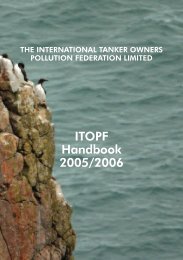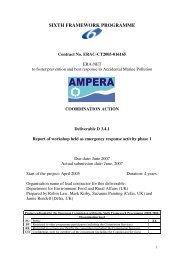A classification tool for N-way arrays based on SIMCA methodology
A classification tool for N-way arrays based on SIMCA methodology
A classification tool for N-way arrays based on SIMCA methodology
Create successful ePaper yourself
Turn your PDF publications into a flip-book with our unique Google optimized e-Paper software.
Overview of 2-<str<strong>on</strong>g>way</str<strong>on</strong>g> <strong>SIMCA</strong><br />
<strong>SIMCA</strong> comparis<strong>on</strong><br />
original <strong>SIMCA</strong>:<br />
‣ score and orthog<strong>on</strong>al<br />
distances are combined<br />
as a “rsd” measure<br />
Class<br />
space<br />
PC2<br />
‣ square distance/rsd of a “new” sample is<br />
compared to square rsd of class by F-test<br />
‣ Score distance is computed from the “box”<br />
boundaries (but can be taken from average<br />
problematic<br />
‣ degree of freedom <str<strong>on</strong>g>for</str<strong>on</strong>g> F-test<br />
‣ scaling factor needed in order to combine<br />
score distance with orthog<strong>on</strong>al <strong>on</strong>e<br />
PC1<br />
S p<br />
(q)<br />
Evoluti<strong>on</strong><br />
‣ using T 2 avoids to define “box” boundaries<br />
‣ using <strong>on</strong>ly Orthog<strong>on</strong>al distances does not take<br />
into account deviati<strong>on</strong>s inside class space<br />
‣ using MD may avoid scaling factor<br />
Rejected by both approaches<br />
Accepted by both approaches<br />
Rejected by original <strong>SIMCA</strong><br />
Accepted by this rule<br />
alternative <strong>SIMCA</strong>:<br />
‣ reduced score distance and orthog<strong>on</strong>al distance are<br />
combined, thus being directly comparable<br />
‣ Score distance is computed from the average<br />
problematic<br />
‣ two different reference distributi<strong>on</strong> are assumed<br />
‣ degree of freedom ()<br />
Class<br />
space<br />
PC2<br />
T 2 lim<br />
T 2<br />
PC1<br />
‣ giving the same weight to both type of distances<br />
Q<br />
<br />
Q<br />
Q lim<br />
Accepted by rules using<br />
<strong>on</strong>ly orthog<strong>on</strong>al distance<br />
T 2<br />
TRICAP 2009<br />
Dr. Marina CocchiMORE chemometrics,<br />
Department of Chemistry-University of Modena






